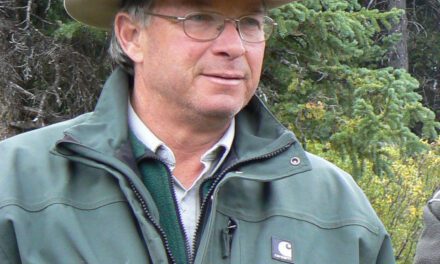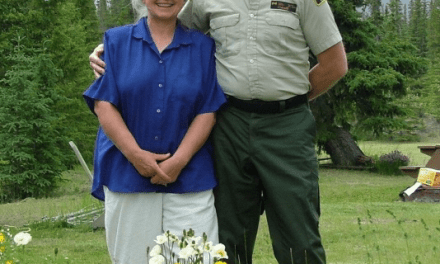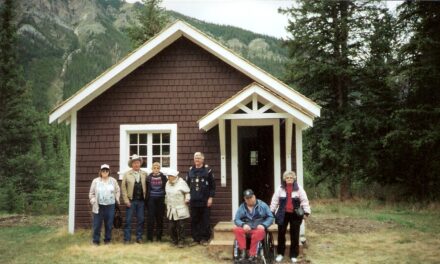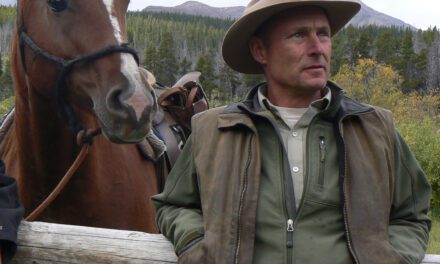
Archaeologist Aaron Osiki examines an Eagle Hunting Pit. Marie Nylund photo.
(0:41:29) Marie – Nellie Murphy was married to Cliff Murphy and he was there (at the Ya Ha Tinda) from about 1929 to 1948. On March 2nd, 1933, they got married and she moved out there. She was a really hardy pioneer. She was from the Gladstone family down around Waterton Lakes. You’ve probably heard of them? Her uncle Wallace was a park warden and I think her dad, Henry Riviere he was a park warden as well. So she came from really hardy stock and when she moved out there, she just loved it! They were very isolated. They would only go into town maybe twice a year.
Did they have children out there too?
No, they didn’t have children, I think until they moved into Banff and adopted a boy. I think that he is still alive and he lives somewhere over in southern B.C. She died about a week or two after our first reunion. She was about 92. (Nellie Murphy was born September 20, 1905 and passed away July 15, 1997) I would have loved it if she had been at that reunion. The lady (Ann Dixon) who wrote Silent Partners, she interviewed her and then she brought me a copy of the tape. She (Nellie) has this wonderful voice, very soft. Really a neat voice to listen to. I think Nellie was a neat lady. She hiked all over the valley, she hiked that whole ranch. She rode the ranch. At that time they had milk cows. It was very much the pioneer life you could say. The old log house with the wood stove. She recalled going down to the old Brewster ranch site and finding the rhubarb that was left there. So the rhubarb that is at the ranch building site, I am pretty sure she must have transplanted it. I always thought it had to be the Brewster rhubarb!
Is there anyone that you worked with that stands out in your mind from the ranch or from the Banff days?
(0:44:00) Marie – Johnny, Perry (Jacobson) was kind of your mentor, getting you going all along, wasn’t he?
Was he from Square Butte too?
(0:44:15) John – He was at Millarville. His family had moved to Millarville in about 1956/57, I think.
(0:44:23) Marie – They chummed around like John and Don and Perry.
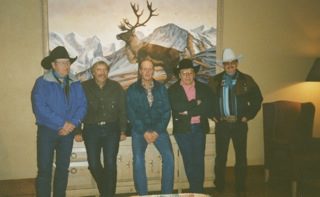
Millarville Mafia – John Nylund, Don Mickle, Bob Haney, Perry Jacobson and Keith Foster
Photo by Marie Nylund
(0:44:20) John – We were always crazy to hunt so that is how we kind of got to know each other.
(0:44:03) Marie –See Perry had gone to Lake Louise as a park warden. It was through him encouraging Johnny to come there to work that Johnny applied for trail crew. Then Jacobsons moved on to Banff and Perry encouraged you to go for the barn boss job.
(0:44:51) John – Actually everybody was good to work with. I didn’t have trouble with anybody really.
(0:45:03) Marie – Well it was that kind of family atmosphere.
(0:45:12) John – Jack Willman when I first started in Banff, he was always wanting me to go with him in the backcountry. So I saw a lot of Banff Park just riding along, tagging along with him. And I travelled a bit with Larry Gilmar as well.
Is Jack Willman still around?
(0:45:39) Marie – He is retired now.
(0:45:45) John – He was at Elk Island. He went from here to Elk Island.
What do you think made that family atmosphere or camaraderie in the warden service?
(0:46:05) Marie – It must have been their common interests. And more of the laid back personalities that get into the warden service.
(0:46:14) John – It was an easy place to work.
(0:46:17) Marie – And the variety of interest. There was never a dull day or never the same day. That was the same with the ranch, there was always something different going on. I remember helping John build a corral. We were building these log corrals and this lady (Norma) came with a truck racing up to us. She jumps out, “My friend broke her pelvis! She is up on the mountain to the south!” Norma came into the house and we phoned the Sundre EMS and told them what was going on. They put us through to STARS. She talked to STARS and they flew out and landed in the yard and took Norma with them. Because they couldn’t tell what the terrain was like at the site where they had to land, Norma could direct them. That was a very rare incident that they landed at the ranch buildings and picked her up and flew her up to the accident site. Norma kind of knew the terrain and told them where to go to the accident site, where it was level enough to land, and they got that other woman out of there.
(0:48:25) John – Then there was the Dogrib fire. They (Parks Canada) were burning at Wigmore in Banff National Park. They were doing a burn up there and anyway this fire started on the Dogrib. I was talking to Brian Low and I told him about this smoke. He figured it was from their fire and it was just drifting down. I had to phone him about three times because it kept on looking like it wasn’t. So he finally said, “I am sure it’s our fire.” Anyway the next morning he flew out there and he thought he would just go down and take a look. Then he went “Whoops!” There were two fires.
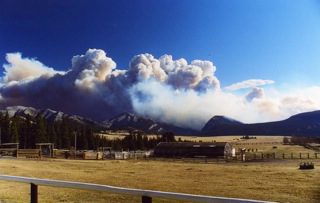
Smoke from Dogrib Fire 2001. Marie Nylund photo.
(0:49:08) Marie – The province sent a forestry crew in there to work on that fire. That was on the 29th of September and on the 16th of October we had tremendous winds and plus 20 which is pretty warm for that time of the year. And that thing blew out! That was a major, huge, huge fire! It swept through Dogrib and out towards the Bearberry. I took several photos of the fire on the afternoon of October 16th, 2001.
(0:49:39) John – It was more than 15 miles or something.
(0:49:43) Marie – Right across the road we had Elaine O’Neill and Dave Oickle to arrive in from Barrier. We knew that they were going to be coming through to the ranch which means they would be coming through that area (the Dogrib). Elaine is one of these people that is packed and ready to go first thing in the morning. At radio call she is on the trail. Always an early person. So Johnny figured that they are going to be right in the middle of that. He said, “I am going to drive around to the Panther trailhead because they’ve got to come out that way hopefully, and not be in the middle of it.” So I phoned dispatch to let them know that that was what was going to happen. John was just about to go and this yellow helicopter landed from forestry. They said, “Well actually the fire has swept across your road, down at the cut blocks and you can’t get out. The Mountainaire Lodge is in jeopardy. Nobody is coming in and out of these roads. We were just hoping that they were safe.
(0:50:36) John – I phoned my brother and asked him if he would go and pick them up, because he lives just at Sundre. If he could find them. Which they did, him and Gary Bracken. They picked them up on their horses and took them out.
(0:50:55) Marie – It is such a narrow valley, you don’t really know what the fire is doing, but you can see this plume of smoke. It was pretty tense. Randy Chisholm and three others from Kootenay Park had ridden in from Scotch Camp and the people that were picking them up were coming out. We were all going to get together for dinner and they had all the food! But they couldn’t get in. So we raided my deep freezer, we managed to eat pretty good! But anyway they were there for a couple of nights before anybody came to get them. And there were hunters at the campground who couldn’t get either in or out. People were (really concerned) because the media of course blew it all up. “The Ya Ha Tinda is gone!” was what the media was saying. We would allow the hunters to come up and use the phone, because they would want to phone home and let their families know that they were actually fine.
(0:52:22) Marie – We had that one and we had that airplane that got stranded too and it had to land. That was another tense moment out there. It was in the fall I think. Whatever time of year, it had been raining and the cloud cover just dropped in the valley. At about 5:00 at night, Johnny noticed this plane coming down the valley from the west. And he just kept going up and down and up and down. He said, “You know what? He is trapped in here.” Sure enough he kept coming up over the house a couple of times. So I phoned dispatch and I said, “Someone is going to have to land or try to land their plane here. He is trapped under this cloud cover.” So Lise (the dispatcher) stayed on the phone with me and Tim Auger (public safety warden) was there with her monitoring the events as Tim thought that they may have to go out, if they crash or something. If it doesn’t work out the way that we hope it will. So the guy flew right over the house. I could read his numbers on the bottom of the plane. And he kind of did what he called a reconnaissance to see what the terraine looked like. Then he made another loop and he landed that thing quite successfully amongst six or seven head of horses! He spent the night. But his plane stayed there for a week or two because…
(0:53:40) John – He had to wait for the right wind to get out of there. He had to have kind of a south wind so he could lift off fast which he did. The pilot had been at some kind of a gathering at Golden with the flying club. He didn’t want to go down the Bow when he left Golden, so he thought that he would go down the Red Deer because he needed to return to the airport at Didsbury. That is why he took that route. But he got in there and he couldn’t get out.
Do you often have people staying at the ranch?
(0:55:08) John – Oh yeah, there was always a warden staying there or archeologists, or somebody doing a study – the wolf studies, the elk studies, the university kids.
“When they were there, were they pretty self sufficient?”
John: Oh yeah, they looked after themselves.
(0:56:15) Marie – That hospitality is something. I enjoyed all the people we met both parks staff and visitors. We met some very interesting people and made some long lasting friendships.
I imagine that you kept the freezer full?
Yes, You do and a good supply of coffee and tea!
(0:56:64) Marie – I think that my worst moments there were when you get the call from the RCMP and this happened a couple of times, “Can you do down to the campground and look up such and such a person because there has been a tragedy in the family.” One that really stuck in my mind was this man who couldn’t speak English. He was from Holland I think. He was with a big group of people. I went down there and found the camp and this lady who he was staying with. She came with us and we brought him up to the ranch. It was the old XJ phone, not the private phone. It had to be the two-way radio. He had to phone and talk to whoever who told him that his mother has died. And he was crying and it was just really awful because you couldn’t communicate with him. You couldn’t even say anything and the other lady, she couldn’t really speak his language either, but she knew that his mom had been sick. That was really heartbreaking.
